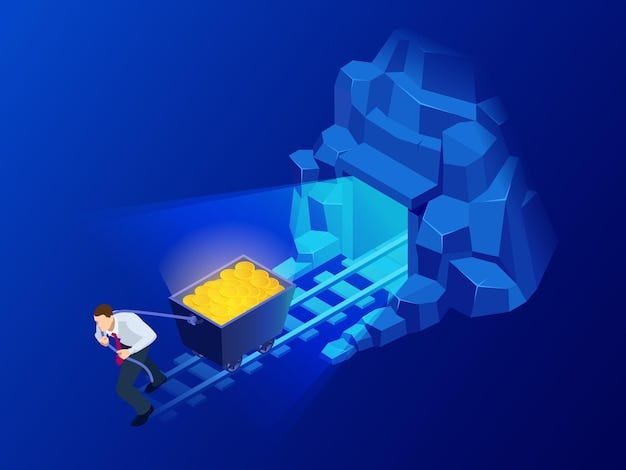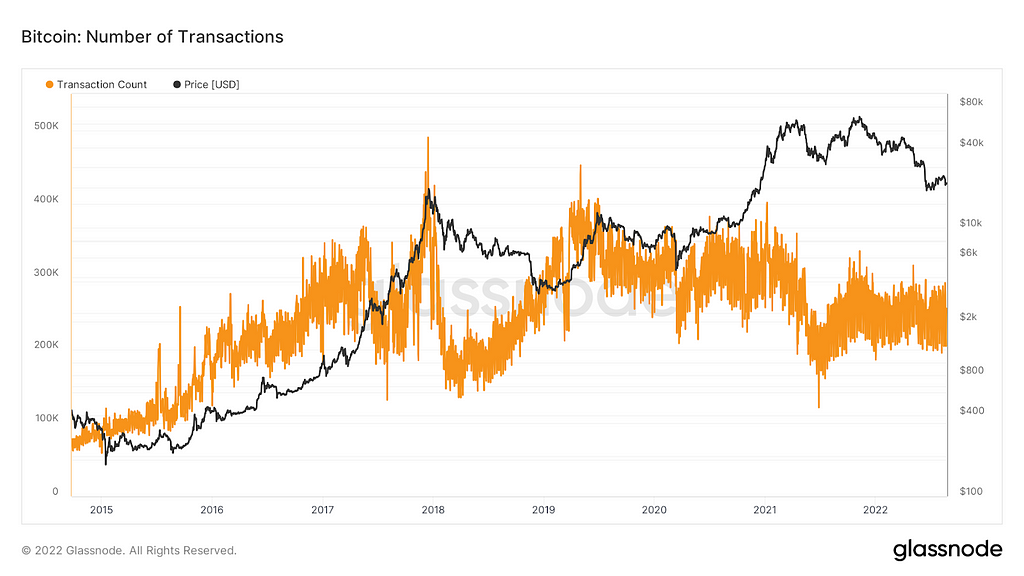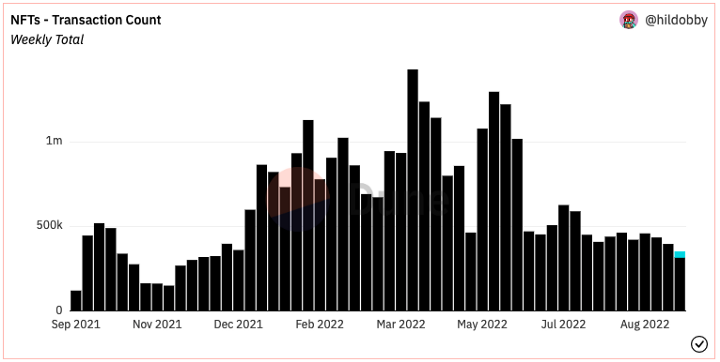And why you should be concerned

Forecasts and price predictions of various tokens are rife across the internet. From supply and inflation schedules to complex financial modeling, it’s all there. This article is not another one of those. Instead, we’re going to explore the future of Bitcoin from a much more fundamental level.
Bitcoin is facing two big challenges for long-term survival. If you’re involved in the Bitcoin ecosystem or you’re invested in the BTC token, you need to be aware of these.
Before we dive, I want to be completely transparent with my views, positions, and biases. I do not hold any BTC myself. I do, however, hold a significant portion of my portfolio in ETH and other ERC20 tokens which obviously rely on the Ethereum network. This is an important note because I draw some comparisons between the Bitcoin and Ethereum networks in this article. Although my aim is to be objective, I want my financial incentive and bias to be clearly stated.
With that out of the way, let’s dive in!
Why Bitcoin? Well, it’s the oldest and most valuable blockchain network by market cap and up until now, it’s been a reliable indicator of how the crypto market is doing as a whole. It’s also the most well known network out there in terms of mainstream media coverage (at least prior to The Merge). Many people look to Bitcoin to determine the health of the crypto market at any given time. This used to be a reliable approach but the future of Bitcoin, however, is much more uncertain than you might think. The king of crypto faces massive long-term security risks which will be challenging, if not impossible, to overcome.
Bitcoin security at a glance
Before we look at what these challenges are, it’s important to have a baseline understanding of how Bitcoin’s security model works.
Bitcoin is what’s called a Proof-of-Work (PoW) blockchain network. This means that Bitcoin’s security relies on a distributed network of miners, solving complex, cryptographic puzzles that require massive amounts of computing power. This kind of computing power costs a lot of money (electricity costs). In return for investing large volumes of energy, miners get a block reward in BTC. The block reward is a mixture of newly issued BTC tokens and transaction fees paid by the users. Bitcoin’s total supply is capped at 21 million tokens. Roughly every 4 years, the new issuance for block rewards is cut in half. This is commonly referred to as a halving event.

By the year 2140, the entire supply of BTC tokens will have been issued. This means that future block rewards will only consist of transaction fees. In order for the network to remain secure, the transaction fees need to present a lucrative enough reward for miners to compete for them. The only way this can happen is through increased network usage. Simply put, people need to use Bitcoin A LOT.
Of the many security analyses and forecasts out there by world-leading experts in Bitcoin, there appears to be plenty of data backing up those transaction fees, as a consequence of increased network usage, will in fact provide a high enough incentive for miners to keep securing the network indefinitely. Whether that’s the case or not will be beyond the scope of this article.
Nonetheless, increased fees require a higher volume of transactions which, in turn, requires exponential network effects. Can Bitcoin achieve this?
Bitcoin Network Effects
How will Bitcoin achieve network effects large enough to sustain the miners through BTC fees when the 21 million tokens have been issued? To answer that, we need to explore the use cases for Bitcoin.
The primary use case for Bitcoin is as a store of value. This isn’t a subjective or biased opinion. Google Michael Saylor and you’ll see what I mean.
In the bull market of 2021, investors turned to Bitcoin as an alternative store of value as well as a hedge against inflation. For first time investors, this didn’t work out quite as expected. Come Q4 of 2022 and their “inflation hedge” is down over 50% on the year and many have fled into fiat cash. Not ideal.
Perhaps Bitcoin wasn’t the safe haven that investors thought. Granted, a store of value asset isn’t necessarily intended to hold for a short period of time. But even if the investors stuck it out in BTC for the long-term, the store of value use case only fulfills one prerequisite for network effect: More active wallets. What it doesn’t do is increase daily peer-to-peer (P2P) transactions. As stated in the previous section, the network needs increased usage to grow and sustain enough transaction fees for miners to remain financially incentivized.
“A true network effect is unlikely to happen before Bitcoin separates its base layer use case (store of value) from its L2 use case (P2P payments).” — Ivan Cryptoslav
If enough people don’t decide that they want to transact with Bitcoin as a means of payment on a daily basis, the network is in big trouble. And that’s the direction it looks like Bitcoin is heading in. If we look at Bitcoin transactions since 2015, we can see that they have been stalling for 3 years. They’re actually in a downward trend. That’s a red flag for investors who believe Bitcoin is growing exponentially as a network.
According to the data, it’s not.

We use MasterCard and American Express because their massive network of vendors allows us to shop anywhere in the world, any time we want. We use LinkedIn because it allows us to connect and network with hundreds of millions of professionals around the world at any given time. These tools have exponential network effects because they’ve got truly valuable use cases. People want and need to use them every day.
Comparing the network effects of Bitcoin to that of Ethereum, we see a stark contrast. Ethereum has around 3,000 applications (dApps) built on it with hundreds of thousands of daily active users and many layer-2 scaling solutions for people to use. Even in the grips of a bear market, there’s over $30 billion locked in smart contracts across the Ethereum ecosystem. This means people are using Ethereum applications.

Why? Because Ethereum offers valuable use cases for users. There are endless use cases on Ethereum beyond P2P transactions. Bitcoin has only one other beyond P2P transactions.
Ethereum has taken a modular approach to its blockchain, allowing thousands of ‘lego pieces’ to plug into the system and compound its value through new and innovative use cases. This is good for network participants and great for the value of the network. The more people who use it, the more engineers will build on it, the more valuable it becomes to users, the more new users will attract to the network. Positive network effects in action.
Despite being in a bear market, NFT transactions on Ethereum have actually INCREASED significantly. I talk more about that in my article on the state of the NFT market in 2022. A recent Cointelegraph report claims that the NFT market alone has been estimated to hit $230 billion by the year 2030. Roughly 80% of all NFTs today are minted on the Ethereum blockchain (down from 95% in 2021!). This represents just one use case out of thousands on the Ethereum network and I’m using it as a way to illustrate the compounding value of the network.

What are the future use cases of Bitcoin that will result in exponential growth? What will attract large swaths of new users to pay for transaction fees? It sure won’t be P2P transactions alone. But unfortunately, there’s another problem. Let’s assume Bitcoin sees exponential network effects in the coming decades and transaction fees reach satisfactory levels for miners (despite my arguments above).
There’s an energy problem, and it’s not what you think.
The Energy Problem?
Blockchain security requires sound cryptoeconomics and game theory. A financial incentive for the miners to act honestly isn’t enough to secure the blockchain. You need a financial disincentive for miners that act dishonestly, punishing bad actors who try to disrupt the network and process fraudulent blocks. Otherwise, there would be nothing stopping bad actors from attempting to disrupt the network at any given time. For Bitcoin miners (and most other Proof-of-Work miners), this comes in the form of energy costs to solve complex, cryptographic puzzles.

Because the cost of mining a Bitcoin block is so high, it becomes financially infeasible to try to process fraudulent blocks on the network. The other nodes would claim this block invalid, and the miner would not get the block reward. For context, the average cost of mining 1 BTC in 2022 across 198 countries has been estimated at $35,000.
So far, so good. Nobody wants to throw away $35K in energy costs for no reason. The game theory plays out, and the Bitcoin network remains secure. But what happens if we remove the cost of energy from the equation?
According to an article by DnB Asset Management, energy prices could drop to zero as early as the year 2050. And DnB aren’t the only ones exploring this idea. SingularityHub and Forbes have both published articles discussing this potential future with similar timelines.
This might be a difficult idea to comprehend given the current state of energy prices, particularly across the European continent that’s staring down the barrel of crippling energy costs. But there’s no doubt energy prices will become exponentially cheaper over time thanks to solar, wind, and nuclear power. What will happen to the security model of Bitcoin when there’s no reason to act honestly as a miner? It all falls apart.
Consequently, the price of the BTC token will plummet, and the network will fade into existence. I’ve not yet heard people in the crypto space address this point at length. Perhaps it’s being conveniently ignored. Perhaps it’s considered an extreme scenario and not worthy of legitimate concern? Either way, if I were invested in Bitcoin, it’s a concern that I’d want answers to.
Check out our new platform 👉 https://thecapital.io/
https://twitter.com/thecapital_io
Bitcoin Has A Problem (or two) was originally published in The Capital on Medium, where people are continuing the conversation by highlighting and responding to this story.
from The Capital - Medium https://ift.tt/XVGfsUq
0 Comments